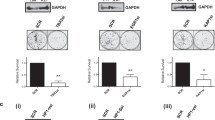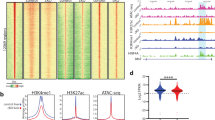Abstract
The Wilms' tumour suppressor gene, WT1, encodes a zinc-finger protein that is mutated in Wilms' tumours and highly expressed in a wide variety of other malignancies. WT1 is a transcription factor that is likely to have additional, post-transcriptional, regulatory roles, although the molecular mechanisms by which WT1 acts remain poorly understood. We have combined genetic and biochemical approaches to show, that endogenous WT1 binds to heterogeneous nuclear ribonuclear protein U (hnRNP-U), that this interaction does not require any other proteins or nucleic acids, involves the zinc-fingers of WT1 and the middle domain of hnRNP-U, and that hnRNP-U can modulate WT1 transcriptional activation of a bona fide WT1 target gene. These findings increase our knowledge of how WT1 exerts its transcriptional regulatory role and suggests that hnRNP-U may be a candidate Wilms' tumour gene at 1q44.
This is a preview of subscription content, access via your institution
Access options
Subscribe to this journal
Receive 50 print issues and online access
$259.00 per year
only $5.18 per issue
Buy this article
- Purchase on Springer Link
- Instant access to full article PDF
Prices may be subject to local taxes which are calculated during checkout




Similar content being viewed by others
References
Armstrong JF, Pritchard-Jones K, Bickmore WA, Hastie ND, Bard JB . (1993). The expression of the Wilms' tumour gene, WT1, in the developing mammalian embryo. Mech Dev 40: 85–97.
Barbaux S, Niaudet P, Gubler MC, Grunfeld JP, Jaubert F, Kuttenn F et al. (1997). Donor splice-site mutations in WT1 are responsible for Frasier syndrome. Nat Genet 17: 467–470.
Bergmann L, Maurer U, Weidmann E . (1997). Wilms' tumor gene expression in acute myeloid leukemias. Leuk Lymphoma 25: 435–443.
Breslow N, Beckwith JB, Ciol M, Sharples K . (1988). Age distribution of Wilms' tumor: report from the National Wilms' Tumor Study. Cancer Res 48: 1653–1657.
Call KM, Glaser T, Ito CY, Buckler AJ, Pelletier J, Haber DA et al. (1990). Isolation and characterization of a zinc finger polypeptide gene at the human chromosome 11 Wilms' tumor locus. Cell 60: 509–520.
Caricasole A, Duarte A, Larsson SH, Hastie ND, Little M, Holmes G et al. (1996). RNA binding by the Wilms tumor suppressor zinc finger proteins. Proc Natl Acad Sci USA 93: 7562–7566.
Carpenter B, Hill KJ, Charalambous M, Wagner KJ, Lahiri D, James DI et al. (2004). BASP1 is a transcriptional cosuppressor for the Wilms' tumor suppressor protein WT1. Mol Cell Biol 24: 537–549.
Challen G, Gardiner B, Caruana G, Kostoulias X, Martinez G, Crowe M et al. (2005). Temporal and spatial transcriptional programs in murine kidney development. Physiol Genomics 23: 159–171.
Davies RC, Calvio C, Bratt E, Larsson SH, Lamond AI, Hastie ND . (1998). WT1 interacts with the splicing factor U2AF65 in an isoform-dependent manner and can be incorporated into spliceosomes. Genes Dev 12: 3217–3225.
Gessler M, Poustka A, Cavenee W, Neve RL, Orkin SH, Bruns GA . (1990). Homozygous deletion in Wilms tumours of a zinc-finger gene identified by chromosome jumping. Nature 343: 774–778.
Hammes A, Guo JK, Lutsch G, Leheste JR, Landrock D, Ziegler U et al. (2001). Two splice variants of the Wilms' tumor 1 gene have distinct functions during sex determination and nephron formation. Cell 106: 319–329.
Hastie ND . (1994). The genetics of Wilms' tumor – a case of disrupted development. Annu Rev Genet 28: 523–558.
Heilbronn R, Engstler M, Weger S, Krahn A, Schetter C, Boshart S . (2003). ssDNA-dependent colocalization of adeno-associated virus Rep and herpes simplex virus ICP8 in nuclear replication domains. Nucleic Acid Res 31: 6206–6213.
Kanai Y, Dohmae N, Hirokawa N . (2004). Kinesin transports RNA: isolation and characterization of an RNA-transporting granule. Neuron 43: 513–525.
Kiledjian M, Dreyfuss G . (1992). Primary structure and binding activity of the hnRNP U protein: binding RNA through RGG box. EMBO J 11: 2655–2664.
Kim MK, Nikodem VM . (1999). hnRNP U inhibits carboxy-terminal domain phosphorylation by TFIIH and represses RNA polymerase II elongation. Mol Cell Biol 19: 6833–6844.
Krecic AM, Swanson MS . (1999). hnRNP complexes: composition, structure, and function. Curr Opin Cell Biol 11: 363–371.
Kukalev A, Nord Y, Palmberg C, Bergman T, Percipalle P . (2005). Actin and hnRNP U cooperate for productive transcription by RNA polymerase II. Nat Struct Mol Biol 12: 238–244.
Ladomery MR, Slight J, Mc Ghee S, Hastie ND . (1999). Presence of WT1, the Wilm's tumor suppressor gene product, in nuclear poly(A)(+) ribonucleoprotein. J Biol Chem 274: 36520–36526.
Larsson SH, Charlieu JP, Miyagawa K, Engelkamp D, Rassoulzadegan M, Ross A et al. (1995). Subnuclear localization of WT1 in splicing or transcription factor domains is regulated by alternative splicing. Cell 81: 391–401.
Lee SB, Huang K, Palmer R, Truong VB, Herzlinger D, Kolquist KA et al. (1999). The Wilms tumor suppressor WT1 encodes a transcriptional activator of amphiregulin. Cell 98: 663–673.
Lee TH, Lwu S, Kim J, Pelletier J . (2002). Inhibition of Wilms tumor 1 transactivation by bone marrow zinc finger 2, a novel transcriptional repressor. J Biol Chem 277: 44826–44837.
Little M, Holmes G, Walsh P . (1999). WT1: what has the last decade told us? BioEssays 21: 191–202.
Loeb DM, Evron E, Patel CB, Sharma PM, Niranjan B, Buluwela L et al. (2001). Wilms' tumor suppressor gene (WT1) is expressed in primary breast tumors despite tumor-specific promoter methylation. Cancer Res 61: 921–925.
Miles CG, Slight J, Spraggon L, O'Sullivan M, Patek C, Hastie ND . (2003). Mice lacking the 68-amino-acid, mammal-specific N-terminal extension of WT1 develop normally and are fertile. Mol Cell Biol 23: 2608–2613.
Nachtigal MW, Hirokawa Y, Enyeart-VanHouten DL, Flanagan JN, Hammer GD, Ingraham HA . (1998). Wilms' tumor 1 and Dax-1 modulate the orphan nuclear receptor SF-1 in sex-specific gene expression. Cell 93: 445–454.
Natoli TA, McDonald A, Alberta JA, Taglienti ME, Housman DE, Kreidberg JA . (2002). A mammal-specific exon of WT1 is not required for development or fertility. Mol Cell Biol 22: 4433–4438.
Niksic M, Slight J, Sanford JR, Caceres JF, Hastie ND . (2004). The Wilms' tumour protein (WT1) shuttles between nucleus and cytoplasm and is present in functional polysomes. Hum Mol Genet 13: 463–471.
Oji Y, Miyoshi S, Takahashi E, Koga S, Nakano Y, Shintani Y et al. (2004). Absence of mutations in the Wilms' tumor gene wt1 in de novo non-small cell lung cancers. Neoplasma 51: 17–20.
Oji Y, Yamamoto H, Nomura M, Nakano Y, Ikeba A, Nakatsuka S et al. (2003). Overexpression of the Wilms' tumor gene WT1 in colorectal adenocarcinoma. Cancer Sci 94: 712–717.
Pinol-Roma S, Choi YD, Matunis MJ, Dreyfuss G . (1988). Immunopurification of heterogeneous nuclear ribonucleoprotein particles reveals an assortment of RNA-binding proteins. Genes Dev 2: 215–227.
Reddy JC, Hosono S, Licht JD . (1995). The transcriptional effect of WT1 is modulated by choice of expression vector. J Biol Chem 270: 29976–29982.
Rivera MN, Haber DA . (2005). Wilms' tumour: connecting tumorigenesis and organ development in the kidney. Nat Rev Cancer 5: 699–712.
Roberts SG . (2005). Transcriptional regulation by WT1 in development. Curr Opin Genet Dev 15: 542–547.
Rodeck U, Bossler A, Kari C, Humphreys CW, Gyorfi T, Maurer J et al. (1994). Expression of the wt1 Wilms' tumor gene by normal and malignant human melanocytes. Int J Cancer 59: 78–82.
Romig H, Fackelmayer FO, Renz A, Ramsperger U, Richter A . (1992). Characterization of SAF-A, a novel nuclear DNA binding protein from HeLa cells with high affinity for nuclear matrix/scaffold attachment DNA elements. EMBO J 11: 3431–3440.
Scharnhorst V, Kranenburg O, van der Eb AJ, Jochemsen AG . (1997). Differential regulation of the Wilms' tumor gene, WT1, during differentiation of embryonal carcinoma and embryonic stem cells. Cell Growth Differ 8: 133–143.
Sim EU, Smith A, Szilagi E, Rae F, Ioannou P, Lindsay MH et al. (2002). Wnt-4 regulation by the Wilms' tumour suppressor gene, WT1. Oncogene 21: 2948–2960.
Wagner N, Wagner KD, Theres H, Englert C, Schedl A, Scholz H . (2005). Coronary vessel development requires activation of the TrkB neurotrophin receptor by the Wilms' tumor transcription factor Wt1. Genes Dev 19: 2631–2642.
Wagner N, Wagner KD, Xing Y, Scholz H, Schedl A . (2004). The major podocyte protein nephrin is transcriptionally activated by the Wilms' tumor suppressor WT1. J Am Soc Nephrol 15: 3044–3051.
Wilhelm D., Englert C . (2002). The Wilms' tumor suppressor WT1 regulates early gonad development by activation of Sf1. Genes Dev 16: 1839–1851.
Williams RD, Hing SN, Greer BT, Whiteford CC, Wei JS, Natrajan R et al. (2004). Prognostic classification of relapsing favorable histology Wilms tumor using cDNA microarray expression profiling and support vector machines. Genes Chromosomes Cancer 41: 65–79.
Yamagami T, Sugiyama H, Inoue K, Ogawa H, Tatekawa T, Hirata M et al. (1996). Growth inhibition of human leukemic cells by WT1 (Wilms tumor gene) antisense oligodeoxynucleotides: implications for the involvement of WT1 in leukemogenesis. Blood 87: 2878–2884.
Zapata-Benavides P, Tuna M, Lopez-Berestein G, Tari AM . (2002). Downregulation of Wilms' tumor 1 protein inhibits breast cancer proliferation. Biochem Biophys Res Commun 295: 784–790.
Acknowledgements
We thank Ms Kippi Rai-Spraggon for helpful insights and preparation of this manuscript and Dr Cathy Mendelsohn for critical reading of this manuscript; also Ms Katie Browne for excellent editorial assistance and Mr Douglas Stuart for help with the figures. We also thank Dr Dominic Campopiano and Dr Nick Tomczyk for technical assistance, Dr Jordan Kreidberg, Dr Klaus Rajewsky, Dr Vera Nikodem, Dr Myung Kim, Dr Gideon Dreyfuss and Dr Julia Dorin for reagents.
Author information
Authors and Affiliations
Corresponding author
Rights and permissions
About this article
Cite this article
Spraggon, L., Dudnakova, T., Slight, J. et al. hnRNP-U directly interacts with WT1 and modulates WT1 transcriptional activation. Oncogene 26, 1484–1491 (2007). https://doi.org/10.1038/sj.onc.1209922
Received:
Revised:
Accepted:
Published:
Issue Date:
DOI: https://doi.org/10.1038/sj.onc.1209922
Keywords
This article is cited by
-
Integrating many co-splicing networks to reconstruct splicing regulatory modules
BMC Systems Biology (2012)
-
Wilms’ tumor 1 silencing decreases the viability and chemoresistance of glioblastoma cells in vitro: a potential role for IGF-1R de-repression
Journal of Neuro-Oncology (2011)
-
Wt1 is required for cardiovascular progenitor cell formation through transcriptional control of Snail and E-cadherin
Nature Genetics (2010)
-
Actin: a novel interaction partner of WT1 influencing its cell dynamic properties
Oncogene (2010)
-
Keep Your Fingers Off My DNA: Protein–Protein Interactions Mediated by C2H2 Zinc Finger Domains
Cell Biochemistry and Biophysics (2008)



